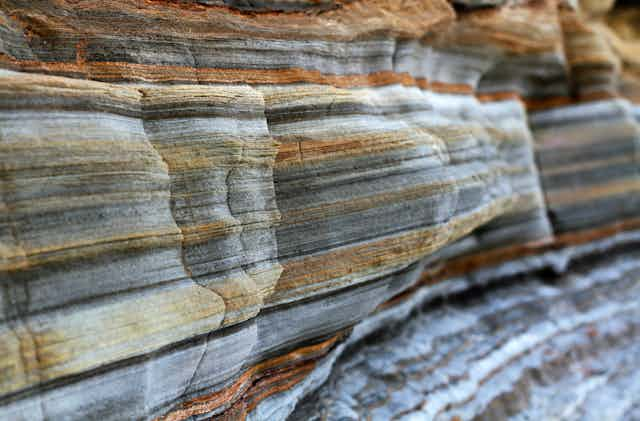The shape of Earth’s orbit around the sun and the orientation of its axis undergo regular variations over periods of thousands to millions of years. These variations — known as Milankovitch cycles after the Serbian geophysicist Milutin Milankovitch — affect the amount of sunlight reaching the planet’s surface.
Milankovitch cycles are one of the main drivers of our climate. We know quite a lot about these variations at the present day because we can precisely measure them. Evidence for climate changes due to changes in the Earth’s orbit is present in the geological record over the past few hundred million years. The evidence appears as variations in the thickness and composition of sedimentary layers of rock.
However, hardly anything is known about these climate changes further back in time, bearing in mind that the Earth is 4.5 billion years old. We have not previously been able to learn much about how these Milankovitch cycles have varied throughout earth’s history — until now.
We are part of a small international team of researchers from Utrecht University, University of Geneva and Université du Québec à Montréal that conduct careful examination of rhythmic layering patterns in rocks. We then combine these with precise age determinations to calculate the rate that the sediments are deposited. This enables us to uncover the climate secrets of the Earth billions of years ago.
Deep history
In one location, the types of sediment deposited at a certain time vary as a function of the climate. Scientists have studied these variations in the sedimentary record in detail, enabling climate changes in the past to be identified precisely. Typically, the method used to study these variations is spectral analysis, where statistical tools determine if there are cyclic variations in the rock layers.
A simple thought experiment can be useful to understand how changes in the climate can affect the rock record.
For example, if you are standing on a beach, the location of the ocean is linked to the amount of sunlight reaching the Earth’s surface. If the Earth was slightly further away from the sun, or the Earth’s axis was pointing slightly further away, the climate would be colder. Some of the water in the oceans would be stored in glaciers on the land, and this would cause a drop in sea level. You would then be more inland and the sediment deposited under your feet would be fundamentally different to beach sand. The opposite would occur if the Earth was slightly closer to the sun, you would not be standing on a beach, but somewhere at the bottom of the ocean as the melting glaciers cause the sea level to rise.

Billions of years ago, conditions on Earth were fundamentally different from those at present: there was no free oxygen in the atmosphere, volcanic activity was more violent and no vegetation or multicellular life had developed. Nevertheless, there must have been fluctuations in the Earth’s orbit and axis that affected the climate at the time, and possibly even affected early life and the chemistry of the oceans.
Banded iron formations
Our research team has been searching for evidence for cyclic climatic variations in 2.5 billion-year-old banded iron formations (BIFs). BIFs are iron-rich, distinctively layered rocks that were widely deposited on the ocean floor and are now found on the oldest extant parts of the Earth’s crust. These rock types are not found in the present day and scientists have struggled to understand both their formation and their banded appearance.
Until now, scientists have explained the deposition of these iron formations and their regular layering mainly as being due to submarine volcanic activity, the hydrothermal source of the iron. In addition, the evolution of photosynthesis at this time may have produced oxygen in the shallowest parts of the ocean. This would have caused the reduced iron dissolved in the water to become oxidized and insoluble, and it would then fall to the ocean bottom.

Our study is the first to conclusively link the regular alternations in the BIFs to cyclical changes in the Earth’s orbit around the sun, with periods of 405,000 years and 1.4 to 1.6 million years. We achieved this by combining spectral analysis of sedimentary layers in South Africa with very precise uranium-lead dating to work out the rate that the sediments were deposited. Our research shows that Milankovitch cycles 2.5 billion years ago had a major effect on both the planet’s climate and on iron deposition in the oceans.
We found that the current 405,000 year cycle occurred 2.5 billion years ago. We also found a cycle that takes 1.4 to 1.6 million years. This cycle may be a modern Milankovitch cycle, the closest present day cycle taking ~2.4 million years. We interpret the difference in timing as being due to chaotic behaviour of the planets in our solar system, which affects the length of some of the Milankovitch cycles.
High-resolution archives
This exciting discovery indicates that BIFs can be considered a high-resolution archive of astronomical climate 2.5 billion years ago. This information will have fundamental implications for our understanding of how the solar system evolved over time. Until now, astrophysical models show how the solar system may have formed and modern telescopes have enabled us to understand what the solar system currently looks like. Information on how we got from the start to the present day configuration is currently missing.
Further research on the cyclic layering in BIFs will be key to understand exactly how the early Earth climate system responded to the astronomical variations.

